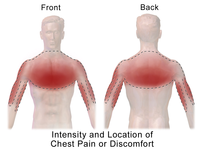
Photo from wikipedia
OBJECTIVE To evaluate the effect new outpatient clinic visits has on the availability of follow-up visits for established patients when patient visit frequency is risk adjusted. DATA SOURCES Diagnosis codes… Click to show full abstract
OBJECTIVE To evaluate the effect new outpatient clinic visits has on the availability of follow-up visits for established patients when patient visit frequency is risk adjusted. DATA SOURCES Diagnosis codes for patients from 2 Internal Medicine Clinics were extracted through billing data. STUDY DESIGN The HHS-HCC risk adjusted scores for each clinic were determined based upon the average of all clinic practitioners' profiles. These scores were then used to project encounter frequencies for established patients, and for new patients entering the clinic based on risk and time of entry into the clinics. PRINCIPAL FINDINGS A distinct mean risk frequency distribution for physicians in each clinic could be defined providing model parameters. Within the model, follow-up visit utilization at the highest risk adjusted visit frequencies would require more follow-up slots than currently available when new patient no-show rates and annual patient loss are included. Patients seen at an intermediate or lower visit risk adjusted frequency could be accommodated when new patient no-show rates and annual patient clinic loss are considered. CONCLUSIONS Value-based care is driven by control of cost while maintaining quality of care. In order to control cost, there has been a drive to increase visit frequency in primary care for those patients at increased risk. Adding new patients to primary care clinics limits the availability of follow-up slots that accrue over time for those at highest risk, thereby limiting disease and, potentially, cost control. If frequency of established care visits can be reduced by improved disease control, closing the practice to new patients, hiring health care extenders, or providing non-face to face care models then quality and cost of care may be improved.
Journal Title: Journal of Evaluation in Clinical Practice
Year Published: 2018
Link to full text (if available)
Share on Social Media: Sign Up to like & get
recommendations!